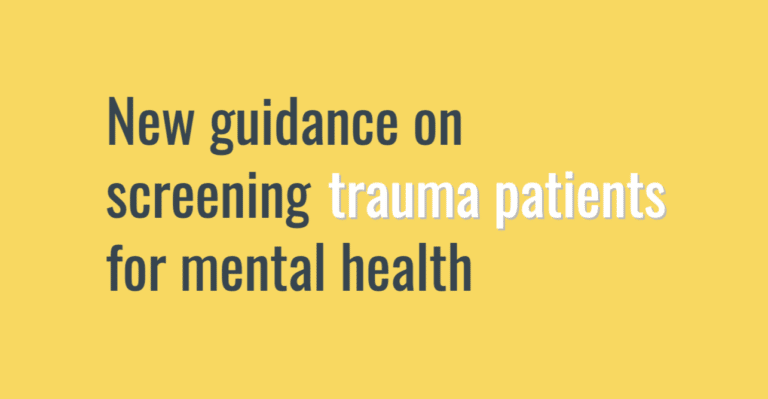The American College of Surgeons (ACS) has released guidelines for screening trauma patients for mental health disorders and substance misuse. The long-awaited guidelines provide trauma program leaders with practical recommendations on how to help injured patients with alcohol and drug use problems as well as post-traumatic stress disorder (PTSD) and depression.
One in five hospitalized trauma victims develops PTSD or depression, according to the new guidelines. In addition, more than half of injured patients who receive care at a trauma center may have a substance use disorder.
“The goal of these guidelines is to identify patients most at risk for mental health and substance misuse issues, intervene to reduce their risk, and then to ensure patients who develop these issues receive needed treatment,” said Christine Cocanour, MD, FACS, chair of the ACS Committee on Trauma PIPS Program and TQP Best Practices Guidelines work group.
The new guidelines provide practical recommendations on:
- Selecting the right SBIRT screening tool for your trauma center
- Establishing rapport with patients as part of the screening process
- Performing the brief intervention for alcohol and drug misuse
- Developing a protocol for screening trauma patients at high risk for psychological sequelae
- Creating a process for referring high-risk patients to a mental health provider
- Developing a hospital-based violence intervention program (HVIP)
- Incorporating suicide screening and intervention into trauma hospitalizations
How the guidelines will help trauma centers comply with ACS standards
The new guidelines can help trauma centers comply with several new requirements within Resources for Optimal Care of the Injured Patient: 2022 Standards.
Standard 5.29 requires Level I and II trauma centers to have a protocol for screening patients at high risk for psychological sequelae of trauma and refer them to a mental health provider. The standard requires Level III trauma centers to have a process for referring patients to a mental health provider when necessary.
Standard 5.30 requires trauma centers to screen all admitted trauma patients older than 12 for alcohol misuse. (A screening rate of at least 80% is required.)
Standard 5.31 requires all trauma centers to provide a brief intervention to at least 80% of patients who screen positive for alcohol misuse. (Level III centers must have a referral process if the intervention cannot be provided as part of inpatient care.)
The new guidelines provide trauma program leaders with the “structured approach” to screening and intervention required by the 2022 Standards.
More resources for helping injured patients with mental health and substance use problems
The ACS Committee on Trauma (COT), along with several U.S. government agencies, has published COT Quick Guide: Alcohol Screening and Brief Intervention (SBI) for Trauma Patients. The guide presents a three-step process for performing alcohol SBI in trauma centers, describes five evidence-based screening instruments for at-risk drinking, and provides guidance on how to create an SBI program.
A working group of the Eastern Association for the Surgery of Trauma (EAST) is developing a practice management guideline on Management of Mental Health Sequelae in Trauma Patients. The goal of the guideline development team is to “provide guidance on early identification of individuals at risk for mental illness as well as evidence-based treatment options to assist our patients in overcoming their traumatic events.”


1 Comment
I’m interested to hear what other level I facilities are doing for their brief intervention for standard 5.31.